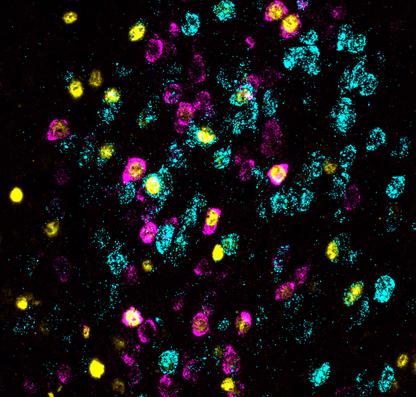
Anti-obesity treatment and the brain
Short description
Our research aims to identify and functionally define the neural circuits that inhibit food intake. Our focus is currently on long-acting GLP-1 analogues and the mechanisms behind their efficiency in reducing body weight. For this purpose, we are e.g. utilizing innovative transgenic mouse models, chemo- and optogenetics, complemented by modern histology (e.g. multiplex immunofluorescence and RNAscope). The results are expected to contribute to our fundamental understanding of how the brain controls our body weight, but also to improved future pharmacological treatment of obesity.
Overarching goal
The overarching goal of our research is to understand how the brain can inhibit food intake and cause body weight loss.
Ongoing project
The effect of GLP-1 analogues on neural circuits
Overweight and obesity are health issues that contribute to development of e.g. type 2 diabetes, cardiovascular disease, cancer and arthritis. In Sweden alone, over 50% of the Swedish population is currently estimated to be overweight or obese, with related healthcare costs amounting to 70 billion SEK per year.
Recently developed long-acting Glucagon-like-1 peptide (GLP-1) analogues have demonstrated highly beneficial effects on long-term weight loss, glycemia and cardiovascular protection. A mechanistic insight into how these analogues act on the brain to reduce appetite and induce weight loss is highly desirable, and will enable even more efficient pharmacological treatments in the future.
Aim
The overarching aim of our research is to gain a deeper understanding on how long-acting GLP-1 analogues act on the brain to promote body weight loss.
Approach
To achieve our goals, we are utilizing conventional and activity-based Cre lines that enables us to identify and manipulate neurons that are responsive to GLP-1 analogues. We employ e.g. chemo- and optogenetics in order to manipulate the activity of identified neuronal populations. This approach enables us to prove causality between activation/inhibition of neural populations and the body weight reducing effects of these analogues. Functional in vivo experiments are complemented with top modern histology and imaging.

Group members
| Linda Engström Ruud | PhD, Researcher, Group Leader |
| Júlia Teixidor Deulofeu | MSc, Doctoral student |
| Sebastian Blid Sköldheden | Doctoral student |
| Ting Liu | Postdoctoral researcher |
Financiers
- Swedish Research Council: Consolidator Grant 2024
- Swedish Brain Foundation 2024
- Novo Nordisk Foundation: Excellence Emerging Investigator Grant within Endocrinology and Metabolism 2021
- Swedish Research Council: Starting Grant 2020


